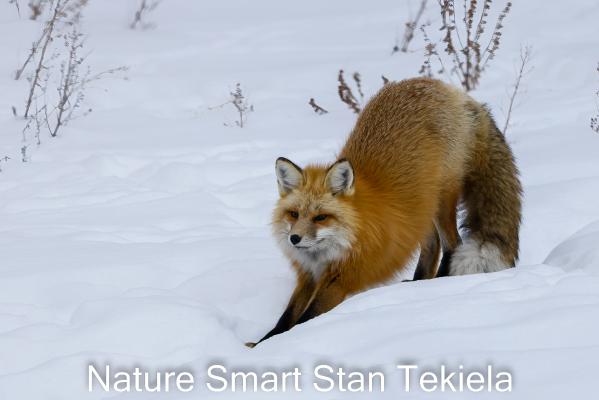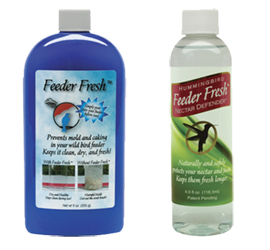View all of the titles in the
NatureSmart Bookstore

by Stan Tekiela
© NatureSmart
March 20, 2023
The Red Fox (Vulpes vulpes) is one of those animals that is common, yet not commonly seen. As you know I spend more than the average time in the outdoors all year long capturing images of wildlife and the Red Fox is one of those animals that I hope to see all the time but for some reason don’t.
So recently while guiding a photo tour in Yellowstone National Park in the depths of winter, I was fortunate enough to spend a couple days with a number of foxes. In fact, one day there was more than just one fox, there was five.
The Red Fox is the largest of the foxes and is found throughout the northern hemisphere including North America, Europe, Asia and parts of North Africa. It has also been introduced by people to Australia. It has an amazing ability to adapt to just about any environment and tolerates being around people very well. In fact, it does so well that it is often found in big cities as well as rural areas. They seem to do very well in suburban areas as well. Some would argue that the Red Fox has followed people in the expansion across the planet.
Despite their common name they come in a wide variety of colors, from nearly black, to blond and many shades between. Some have red bodies but black legs and other combinations. The different coloring often gives rise to different names such as Cross Fox or Silver Fox. These names are often used for animals with dark or gray or silver tipped dark fur. But no matter what color coat of the fox, one thing remains consistent, the tip of the tail. The Red Fox has a white tip of the tail, while its close cousin the Gray Fox (Urocyon cinereoargenteus) has a black tip of the tail. All of these color variations have led to biologists identifying many sub-species. Some recognize upwards of 45 different sub-species for the Red Fox. Don’t get me started on the sub-species topic.
The Red Fox is a master at finding food. They eat mostly small mammals such as mice, voles and shrews along with larger mammals such as rabbits and squirrels. They also eat a wide variety of small birds, reptiles, and amphibians. They are opportunistic feeders, which means they will take advantage of any food source they find in addition to hunting for themselves. It is not uncommon for a fox to stash food for later use. Some recent studies show foxes have the ability to remember where they hid most of what they had hidden weeks before.
Male foxes are called dogs and females are called vixens. The young foxes are called kits. The name fox comes from the old English which derived from the Germanic fuhsaz and refers to the thickly furred tail.
Many people mistakenly believe that Red Foxes were introduced to North America. Recent gene mapping shows that Red Foxes came to North America about 400,000 years ago. Our foxes have been isolated from their European (Old World) counterparts for so long that they are starting to look different and perhaps become a separate species. Yes, some Red Foxes have been introduced to North America in the 1900’s, but it seems that the genes from these introduced foxes didn’t survive.
While foxes have excellent sense of smell, their true super power is their hearing. They have the ability to hear a mouse at 300 feet and can pinpoint with deadly accuracy a mouse under several feet of snow. While photographing several Red Foxes we watched as they cock their head from side to side, with their ears pointed forward in total concentration. They push back against their hind legs like winding up a spring. When they have pin pointed the mouse under the snow they launch themselves into the air and plunge through the snow pinning the prey down to the ground with the front paws before grabbing it with their mouth.
I have been taking trips to Yellowstone in the winter for over 20 years and this winter was the best I have ever seen for Red Foxes. Normally I would see one or two over a couple weeks. This year I was fortunate enough to have many foxes over several days making it one of the best trips for Red Foxes in a very long time. Until next time…
Stan Tekiela is an author / naturalist and wildlife photographer who travels the world to study and capture images of wildlife. He can be followed at www.instagram.com, and www.facebook.com. He can be contacted via his web page at www.naturesmart.com.
The nationally syndicated NatureSmart Column appears in over 25 cities spanning 7 states: Minnesota, Wisconsin, Michigan, Illinois, Ohio, New York and Pennsylvania. It is a bi-weekly column circulated to over 750,000 readers.
Horned Lark
The overall population of ground nesting birds is steadily going down. Here in North America, we have hundreds of bird species who nest directly on the ground. Prairie birds such as Eastern and Western Meadowlarks are a good example. If you are older than 50 you most likely remember hearing...
Sharp-tailed Grouse
The rights of spring come in many different forms, shapes, colors, and patterns. But the end goal is always exactly the same—reproduction. In nature, everything can be boiled down to one of two things, finding food to survive and mating for reproduction. It’s as simple as...
Greater Prairie Chicken
I am not a stranger to getting up at O’ dark thirty, to be able to get out and capture some images of wildlife. Over the past 40 years I would say it is definitely in the hundreds if not thousands of times I’ve dragged myself out of bed so early. So, last week when the alarm went off...
Marsh Rabbit
For me, I enjoy all aspects of nature, not just birds. I find all of nature fascinating and that is what keeps me interested. So, while leading a photo tour to Florida recently I was so excited to see a crazy cool critter that isn’t what you expect when you see it. A true rule...
Each year, during June and July, Stan Tekiela offers two world-class wildlife photography tours. Here's your chance to learn some tricks of the trade from a top professional.
View all of the titles in the
NatureSmart Bookstore
Check out Stan's latest photos at
NatureSmart Wildlife Images
Do you have any interesting wildlife in your backyard? Any nesting birds, deer, turkeys, reptiles, amphibians, or other unique wildlife? Or maybe a fox or coyote den?
If so, contact Stan at stan@naturesmart.com with your backyard wildlife. If he can get a good photo of the subject, he will send you a print of the photo to hang on your wall.
Order Prints and posters of Stan's photos at
» Prints & Posters
Hear Stan on radio stations all across the Midwest.
» More Info

When he's out in the field, Stan relies on his Vortex Razor binoculars and Vortex Razor spotting scope to help find the subjects for his award winning wildlife photography.

For thirty years, professional wildlife photographer Stan Tekiela has counted on Hunt's Photo and Video to provide him with professional photography equipment.
From tripods to camera bodies and lenses, Hunt's has been Stan's place for everything that he needs. Personal service and prompt shipping means Stan can count on Hunt's to support his professional wildlife photography career.


Professional Wildlife Photographer Stan Tekiela always uses Feeder Fresh in his seed feeders to help keep the feeders and food dry, clean and mold free.
He also uses Feeder Fresh Nectar Defender in all of his hummingbird feeders. It safely keeps nectar fresh longer.